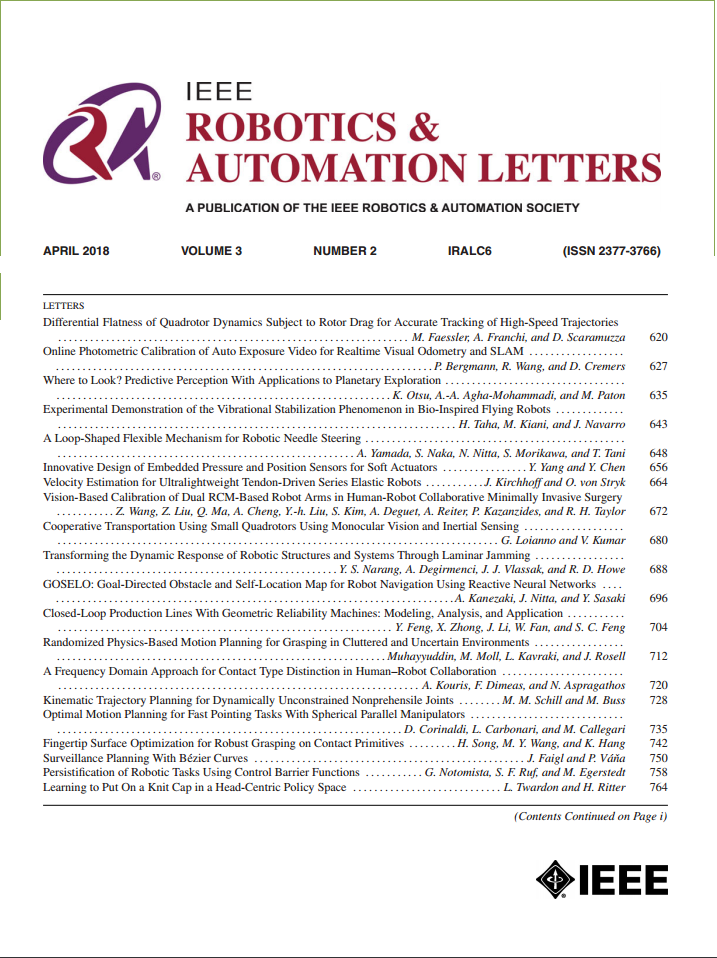家庭紧急情况-使用音频查找和应对家庭紧急情况
IF 4.6
2区 计算机科学
Q2 ROBOTICS
引用次数: 0
摘要
仅在美国,每年家庭意外死亡人数就超过12.8万人。我们的工作旨在使家庭机器人能够对家庭中的紧急情况做出反应,防止受伤和死亡。我们引入了一个基于ThreeDWorld模拟器的家庭紧急情况新数据集。我们数据集中的每个场景都以瞬时或周期性的声音开始,这可能是也可能不是紧急情况。智能体必须使用先前的观察,以及来自模拟器的音频信号和图像来导航多房间的家庭场景,以确定是否存在紧急情况。除了我们的新数据集,我们还提出了一种模块化的方法来定位和识别潜在的家庭紧急情况。支撑我们方法的是一种新的概率动态场景图(P-DSG),其中我们的关键见解是与代理对应的图节点可以用概率边表示。当使用贝叶斯推理进行细化时,该边缘可以实现场景中代理的高效和有效定位。我们还利用多模态视觉语言模型(VLMs)作为我们方法的一个组成部分,确定物体特征(例如易燃性)和识别紧急情况。我们展示了我们的方法在消费者机器人上完成我们的任务的真实版本,展示了我们的任务和方法的可移植性。我们的数据集将在这封信发表后向公众发布。本文章由计算机程序翻译,如有差异,请以英文原文为准。
HomeEmergency - Using Audio to Find and Respond to Emergencies in the Home
In the United States alone accidental home deaths exceed 128,000 per year. Our work aims to enable home robots who respond to emergency scenarios in the home, preventing injuries and deaths. We introduce a new dataset of household emergencies based in the ThreeDWorld simulator. Each scenario in our dataset begins with an instantaneous or periodic sound which may or may not be an emergency. The agent must navigate the multi-room home scene using prior observations, alongside audio signals and images from the simulator, to determine if there is an emergency or not. In addition to our new dataset, we present a modular approach for localizing and identifying potential home emergencies. Underpinning our approach is a novel probabilistic dynamic scene graph (P-DSG), where our key insight is that graph nodes corresponding to agents can be represented with a probabilistic edge. This edge, when refined using Bayesian inference, enables efficient and effective localization of agents in the scene. We also utilize multi-modal vision-language models (VLMs) as a component in our approach, determining object traits (e.g. flammability) and identifying emergencies. We present a demonstration of our method completing a real-world version of our task on a consumer robot, showing the transferability of both our task and our method. Our dataset will be released to the public upon this letters publication.
求助全文
通过发布文献求助,成功后即可免费获取论文全文。
去求助
来源期刊

IEEE Robotics and Automation Letters
Computer Science-Computer Science Applications
CiteScore
9.60
自引率
15.40%
发文量
1428
期刊介绍:
The scope of this journal is to publish peer-reviewed articles that provide a timely and concise account of innovative research ideas and application results, reporting significant theoretical findings and application case studies in areas of robotics and automation.
 求助内容:
求助内容: 应助结果提醒方式:
应助结果提醒方式:


